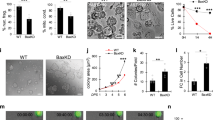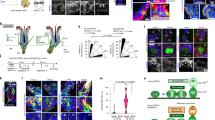Abstract
Adult stem cells (SCs) are at high risk of accumulating deleterious mutations because they reside and self-renew in adult tissues for extended periods. Little is known about how adult SCs sense and respond to DNA damage within their natural niche. Here, using mouse epidermis as a model, we define the functional consequences and the molecular mechanisms by which adult SCs respond to DNA damage. We show that multipotent hair-follicle-bulge SCs have two important mechanisms for increasing their resistance to DNA-damage-induced cell death: higher expression of the anti-apoptotic gene Bcl-2 and transient stabilization of p53 after DNA damage in bulge SCs. The attenuated p53 activation is the consequence of a faster DNA repair activity, mediated by a higher non-homologous end joining (NHEJ) activity, induced by the key protein DNA-PK. Because NHEJ is an error-prone mechanism, this novel characteristic of adult SCs may have important implications in cancer development and ageing.
This is a preview of subscription content, access via your institution
Access options
Subscribe to this journal
Receive 12 print issues and online access
$209.00 per year
only $17.42 per issue
Buy this article
- Purchase on Springer Link
- Instant access to full article PDF
Prices may be subject to local taxes which are calculated during checkout








Similar content being viewed by others
References
Rossi, D. J., Jamieson, C. H. & Weissman, I. L. Stems cells and the pathways to aging and cancer. Cell 132, 681–696 (2008).
Garinis, G. A., van der Horst, G. T., Vijg, J. & Hoeijmakers, J. H. DNA damage and ageing: new-age ideas for an age-old problem. Nature Cell Biol. 10, 1241–1247 (2008).
Harper, J. W. & Elledge, S. J. The DNA damage response: ten years after. Mol. Cell 28, 739–745 (2007).
Hoeijmakers, J. H. Genome maintenance mechanisms for preventing cancer. Nature 411, 366–374 (2001).
Harrison, J. C. & Haber, J. E. Surviving the breakup: the DNA damage checkpoint. Annu. Rev. Genet. 40, 209–235 (2006).
O'Driscoll, M. & Jeggo, P. A. The role of double-strand break repair — insights from human genetics. Nature Rev. Genet. 7, 45–54 (2006).
Wyman, C. & Kanaar, R. DNA double-strand break repair: all's well that ends well. Annu. Rev. Genet. 40, 363–383 (2006).
d'Adda di Fagagna, F. Living on a break: cellular senescence as a DNA-damage response. Nature Rev. Cancer 8, 512–522 (2008).
Riley, T., Sontag, E., Chen, P. & Levine, A. Transcriptional control of human p53-regulated genes. Nature Rev. Mol. Cell Biol. 9, 402–412 (2008).
Morrison, S. J. & Spradling, A. C. Stem cells and niches: mechanisms that promote stem cell maintenance throughout life. Cell 132, 598–611 (2008).
Blanpain, C. & Fuchs, E. Epidermal homeostasis: a balancing act of stem cells in the skin. Nature Rev. Mol. Cell Biol. 10, 207–217 (2009).
Trempus, C. S. et al. Enrichment for living murine keratinocytes from the hair follicle bulge with the cell surface marker CD34. J. Invest. Dermatol. 120, 501–511 (2003).
Blanpain, C., Lowry, W. E., Geoghegan, A., Polak, L. & Fuchs, E. Self-renewal, multipotency, and the existence of two cell populations within an epithelial stem cell niche. Cell 118, 635–648 (2004).
Tumbar, T. et al. Defining the epithelial stem cell niche in skin. Science 303, 359–363 (2004).
Morris, R. J. et al. Capturing and profiling adult hair follicle stem cells. Nature Biotechnol. 22, 411–417 (2004).
Weil, M. M., Amos, C. I., Mason, K. A. & Stephens, L. C. Genetic basis of strain variation in levels of radiation-induced apoptosis of thymocytes. Radiat. Res. 146, 646–651 (1996).
Gudkov, A. V. & Komarova, E. A. The role of p53 in determining sensitivity to radiotherapy. Nature Rev. Cancer 3, 117–129 (2003).
Wilson, C. et al. Cells within the bulge region of mouse hair follicle transiently proliferate during early anagen: heterogeneity and functional differences of various hair cycles. Differentiation 55, 127–136 (1994).
Inomata, K. et al. Genotoxic stress abrogates renewal of melanocyte stem cells by triggering their differentiation. Cell 137, 1088–1099 (2009).
Youssef, K. K. et al. Identification of the cell lineage at the origin of basal cell carcinoma. Nature Cell Biol. 12, 299–305 (2010).
Song, S. & Lambert, P. F. Different responses of epidermal and hair follicular cells to radiation correlate with distinct patterns of p53 and p21 induction. Am. J. Pathol. 155, 1121–1127 (1999).
Botchkarev, V. A. et al. p53 is essential for chemotherapy-induced hair loss. Cancer Res. 60, 5002–5006 (2000).
Michalak, E., Villunger, A., Erlacher, M. & Strasser, A. Death squads enlisted by the tumour suppressor p53. Biochem. Biophys. Res. Commun. 331, 786–798 (2005).
Youle, R. J. & Strasser, A. The BCL-2 protein family: opposing activities that mediate cell death. Nature Rev. Mol. Cell Biol. 9, 47–59 (2008).
Stenn, K. S., Lawrence, L., Veis, D., Korsmeyer, S. & Seiberg, M. Expression of the bcl-2 protooncogene in the cycling adult mouse hair follicle. J. Invest. Dermatol. 103, 107–111 (1994).
Michaelidis, T. M. et al. Inactivation of bcl-2 results in progressive degeneration of motoneurons, sympathetic and sensory neurons during early postnatal development. Neuron 17, 75–89 (1996).
Mendrysa, S. M. et al. mdm2 is critical for inhibition of p53 during lymphopoiesis and the response to ionizing irradiation. Mol. Cell. Biol. 23, 462–472 (2003).
Harris, S. L. & Levine, A. J. The p53 pathway: positive and negative feedback loops. Oncogene 24, 2899–2908 (2005).
Siliciano, J. D. et al. DNA damage induces phosphorylation of the amino terminus of p53. Genes Dev. 11, 3471–3481 (1997).
Bonner, W. M. et al. γH2AX and cancer. Nature Rev. Cancer 8, 957–967 (2008).
Schultz, L. B., Chehab, N. H., Malikzay, A. & Halazonetis, T. D. p53 binding protein 1 (53BP1) is an early participant in the cellular response to DNA double-strand breaks. J. Cell Biol. 151, 1381–1390 (2000).
Hakem, R. DNA-damage repair; the good, the bad, and the ugly. EMBO J. 27, 589–605 (2008).
Araki, R. et al. Nonsense mutation at Tyr-4046 in the DNA-dependent protein kinase catalytic subunit of severe combined immune deficiency mice. Proc. Natl Acad. Sci. USA 94, 2438–2443 (1997).
Woo, R. A., McLure, K. G., Lees-Miller, S. P., Rancourt, D. E. & Lee, P. W. DNA-dependent protein kinase acts upstream of p53 in response to DNA damage. Nature 394, 700–704 (1998).
Biedermann, K. A., Sun, J. R., Giaccia, A. J., Tosto, L. M. & Brown, J. M. scid mutation in mice confers hypersensitivity to ionizing radiation and a deficiency in DNA double-strand break repair. Proc. Natl Acad. Sci. USA 88, 1394–1397 (1991).
Fulop, G. M. & Phillips, R. A. The scid mutation in mice causes a general defect in DNA repair. Nature 347, 479–482 (1990).
Potten, C. S., Wilson, J. W. & Booth, C. Regulation and significance of apoptosis in the stem cells of the gastrointestinal epithelium. Stem Cells 15, 82–93 (1997).
Barker, N. et al. Identification of stem cells in small intestine and colon by marker gene Lgr5. Nature 449, 1003–1007 (2007).
Marshman, E., Booth, C. & Potten, C. S. The intestinal epithelial stem cell. BioEssays 24, 91–98 (2002).
Sangiorgi, E. & Capecchi, M. R. Bmi1 is expressed in vivo in intestinal stem cells. Nature Genet. 40, 915–920 (2008).
Wilson, J. W., Pritchard, D. M., Hickman, J. A. & Potten, C. S. Radiation-induced p53 and p21WAF-1/CIP1 expression in the murine intestinal epithelium: apoptosis and cell cycle arrest. Am. J. Pathol. 153, 899–909 (1998).
Potten, C. S., Owen, G. & Booth, D. Intestinal stem cells protect their genome by selective segregation of template DNA strands. J. Cell Sci. 115, 2381–2388 (2002).
Fitzgerald, T. J. et al. Radiation therapy toxicity to the skin. Dermatol. Clin. 26, 161–172, ix (2008).
Stone, H. B., Coleman, C. N., Anscher, M. S. & McBride, W. H. Effects of radiation on normal tissue: consequences and mechanisms. Lancet Oncol. 4, 529–536 (2003).
Dorr, W. Skin and other reactions to radiotherapy — clinical presentation and radiobiology of skin reactions. Front. Radiat. Ther. Oncol. 39, 96–101 (2006).
Kim, D. J. et al. Targeted disruption of Bcl-xL in mouse keratinocytes inhibits both UVB- and chemically induced skin carcinogenesis. Mol. Carcinog. 48, 873–885 (2009).
Merritt, A. J. et al. The role of p53 in spontaneous and radiation-induced apoptosis in the gastrointestinal tract of normal and p53-deficient mice. Cancer Res. 54, 614–617 (1994).
Merritt, A. J. et al. Differential expression of bcl-2 in intestinal epithelia. Correlation with attenuation of apoptosis in colonic crypts and the incidence of colonic neoplasia. J. Cell Sci. 108, 2261–2271 (1995).
Potten, C. S. Radiation, the ideal cytotoxic agent for studying the cell biology of tissues such as the small intestine. Radiat. Res. 161, 123–136 (2004).
Kemp, C. J., Vo, K. & Gurley, K. E. Resistance to skin tumorigenesis in DNAPK-deficient SCID mice is not due to immunodeficiency but results from hypersensitivity to TPA-induced apoptosis. Carcinogenesis 20, 2051–2056 (1999).
Ramalho-Santos, M., Yoon, S., Matsuzaki, Y., Mulligan, R. C. & Melton, D. A. 'Stemness': transcriptional profiling of embryonic and adult stem cells. Science 298, 597–600 (2002).
Ivanova, N. B. et al. A stem cell molecular signature. Science 298, 601–604 (2002).
Rossi, D. J. et al. Deficiencies in DNA damage repair limit the function of haematopoietic stem cells with age. Nature 447, 725–729 (2007).
Nijnik, A. et al. DNA repair is limiting for haematopoietic stem cells during ageing. Nature 447, 686–690 (2007).
Ploemacher, R. E., van Os, R., van Beurden, C. A. & Down, J. D. Murine haemopoietic stem cells with long-term engraftment and marrow repopulating ability are more resistant to gamma-radiation than are spleen colony forming cells. Int. J. Radiat. Biol. 61, 489–499 (1992).
Meijne, E. I. et al. The effects of x-irradiation on hematopoietic stem cell compartments in the mouse. Exp. Hematol. 19, 617–623 (1991).
Down, J. D., Boudewijn, A., van Os, R., Thames, H. D. & Ploemacher, R. E. Variations in radiation sensitivity and repair among different hematopoietic stem cell subsets following fractionated irradiation. Blood 86, 122–127 (1995).
Acknowledgements
We thank the members of the Blanpain and Vanderhaeghen laboratories for comments during the realization of this study. We thank V. de Maertelaer for help with the statistical analyses. C.B. is a chercheur qualifié of the Fonds de la Recherche Scientifique (F.R.S.)/Fonds National de la Recherche Scientifique (FNRS). A.C. is a research fellow of the F.R.S./Fonds pour la formation à la Recherche dans l'Industrie et dans l'Agriculture (FRIA). This work was supported by a 'mandat d'impulsion scientifique' of the FNRS, a career development award of the Human Frontier Science Program Organization (HFSPO), a research grant of the Schlumberger Foundation, the programme CIBLES of the Wallonia Region, a research grant from the Fondation Contre le Cancer and the fond Gaston Ithier, a starting grant of the European Research Council (ERC) and the EMBO Young Investigator Program.
Author information
Authors and Affiliations
Contributions
C.B., P.A.S., A.C., S.D.C., G.D. and J.C.M. designed the experiments and performed data analysis. P.A.S., A.C., K.K.Y., G.M. and G.L. performed most of the experiments. S.D.C., G.D. and JC.M. performed the western blot analysis. E.D. and C.S. provided technical support. C.B. and P.A.S. wrote the manuscript.
Corresponding author
Ethics declarations
Competing interests
The authors declare no competing financial interests.
Supplementary information
Supplementary Information
Supplementary Information (PDF 2012 kb)
Rights and permissions
About this article
Cite this article
Sotiropoulou, P., Candi, A., Mascré, G. et al. Bcl-2 and accelerated DNA repair mediates resistance of hair follicle bulge stem cells to DNA-damage-induced cell death. Nat Cell Biol 12, 572–582 (2010). https://doi.org/10.1038/ncb2059
Received:
Accepted:
Published:
Issue Date:
DOI: https://doi.org/10.1038/ncb2059
This article is cited by
-
Short- and long-term polystyrene nano- and microplastic exposure promotes oxidative stress and divergently affects skin cell architecture and Wnt/beta-catenin signaling
Particle and Fibre Toxicology (2023)
-
PGD2 displays distinct effects in diffuse large B-cell lymphoma depending on different concentrations
Cell Death Discovery (2023)
-
Radiation-induced gastrointestinal (GI) syndrome as a function of age
Cell Death Discovery (2023)
-
Emerging and established therapies for chemotherapy-induced ototoxicity
Journal of Cancer Survivorship (2023)
-
PKMYT1: A Potential Target for CCNE1 Amplificated Colorectal Tumors
Cell Biochemistry and Biophysics (2023)



